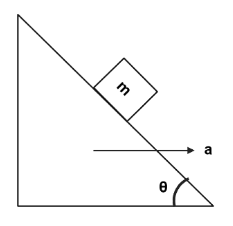
By what acceleration, the wedge should move so that the block moves upwards along the surface of the wedge with an acceleration of $g\sin \theta $.

A. $2g\cos \theta $
B. $g\sin \theta $
C. $2g\tan \theta $
D. $g\cos \theta $

Answer
506.1k+ views
Hint:To construct a free-body diagram, we draw the point of concern, all forces acting on it, and resolve all force vectors into x– and y–components. A separate free-body diagram is required for each object in the question.
Complete step by step answer:
After drawing a free body diagram, we will get the following figure,

In the following question, we observe with respect to wedge. Hence, we apply pseudo force on the block. After substituting the values from free body diagram we will get,
$ma\cos \theta - mg\sin \theta = ma' \\
\Rightarrow ma\cos \theta - mg\sin \theta = mg\sin \theta \\
\Rightarrow a\cos \theta = 2g\sin \theta \\
\Rightarrow a = \dfrac{{2g\sin \theta }}{{\cos \theta }} \\
\therefore a = 2g\tan \theta \\ $
Hence, the correct option is C.
Note:Four forces are not often applied to objects. In certain cases, the number of forces described by a free-body diagram may be one, two, or three. In a free-body diagram, the number of forces that must be drawn is not a hard and fast rule. There is only one guideline to drawing free-body diagrams: reflect all of the forces that exist with that object in the given situation.
Complete step by step answer:
After drawing a free body diagram, we will get the following figure,

In the following question, we observe with respect to wedge. Hence, we apply pseudo force on the block. After substituting the values from free body diagram we will get,
$ma\cos \theta - mg\sin \theta = ma' \\
\Rightarrow ma\cos \theta - mg\sin \theta = mg\sin \theta \\
\Rightarrow a\cos \theta = 2g\sin \theta \\
\Rightarrow a = \dfrac{{2g\sin \theta }}{{\cos \theta }} \\
\therefore a = 2g\tan \theta \\ $
Hence, the correct option is C.
Note:Four forces are not often applied to objects. In certain cases, the number of forces described by a free-body diagram may be one, two, or three. In a free-body diagram, the number of forces that must be drawn is not a hard and fast rule. There is only one guideline to drawing free-body diagrams: reflect all of the forces that exist with that object in the given situation.
Recently Updated Pages
Why are manures considered better than fertilizers class 11 biology CBSE

Find the coordinates of the midpoint of the line segment class 11 maths CBSE

Distinguish between static friction limiting friction class 11 physics CBSE

The Chairman of the constituent Assembly was A Jawaharlal class 11 social science CBSE

The first National Commission on Labour NCL submitted class 11 social science CBSE

Number of all subshell of n + l 7 is A 4 B 5 C 6 D class 11 chemistry CBSE

Trending doubts
What is meant by exothermic and endothermic reactions class 11 chemistry CBSE

1 Quintal is equal to a 110 kg b 10 kg c 100kg d 1000 class 11 physics CBSE

What is periodicity class 11 chemistry CBSE

What is a periderm How does periderm formation take class 11 biology CBSE

Mention the basic forces in nature class 11 physics CBSE

What are porins class 11 biology CBSE




